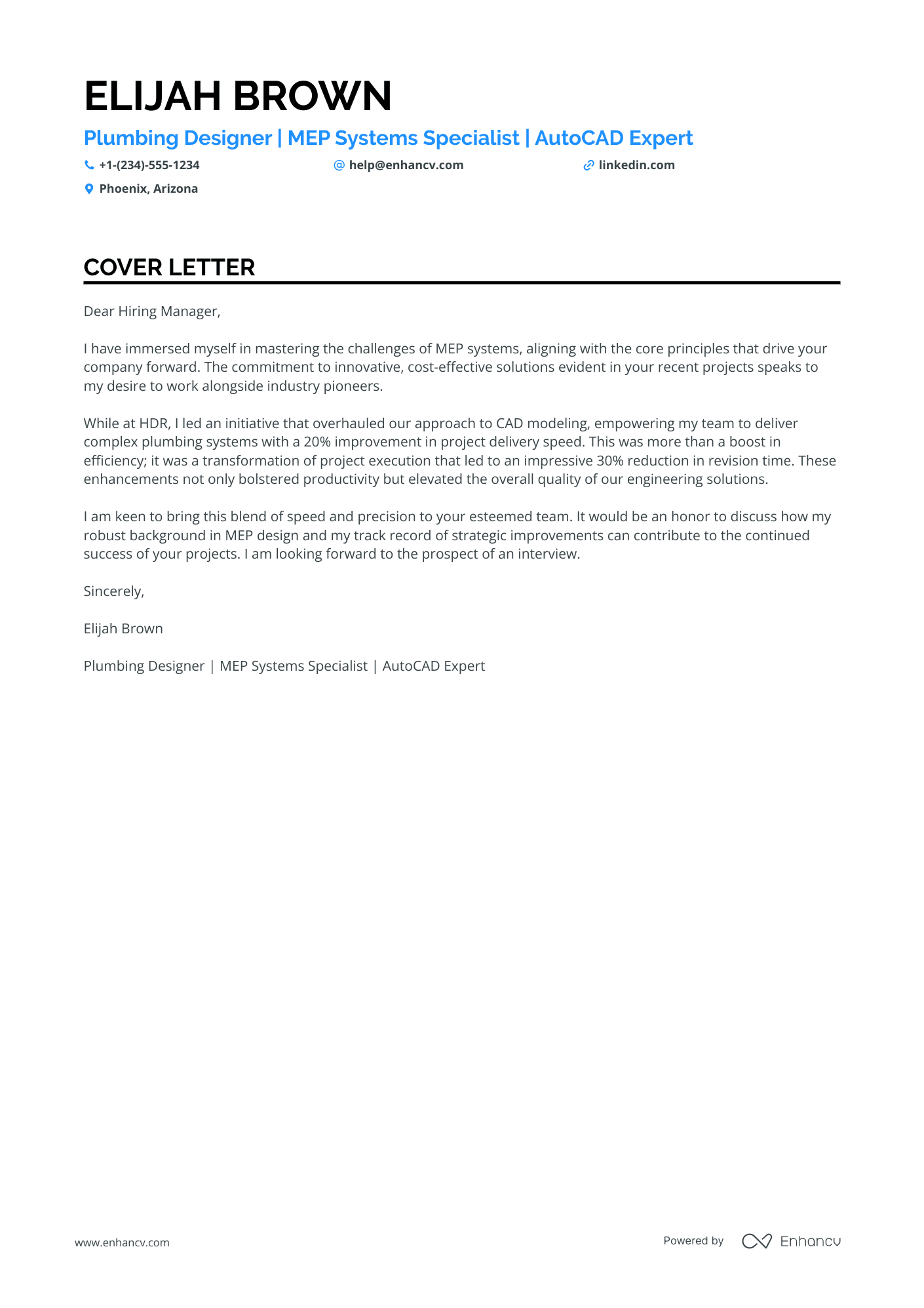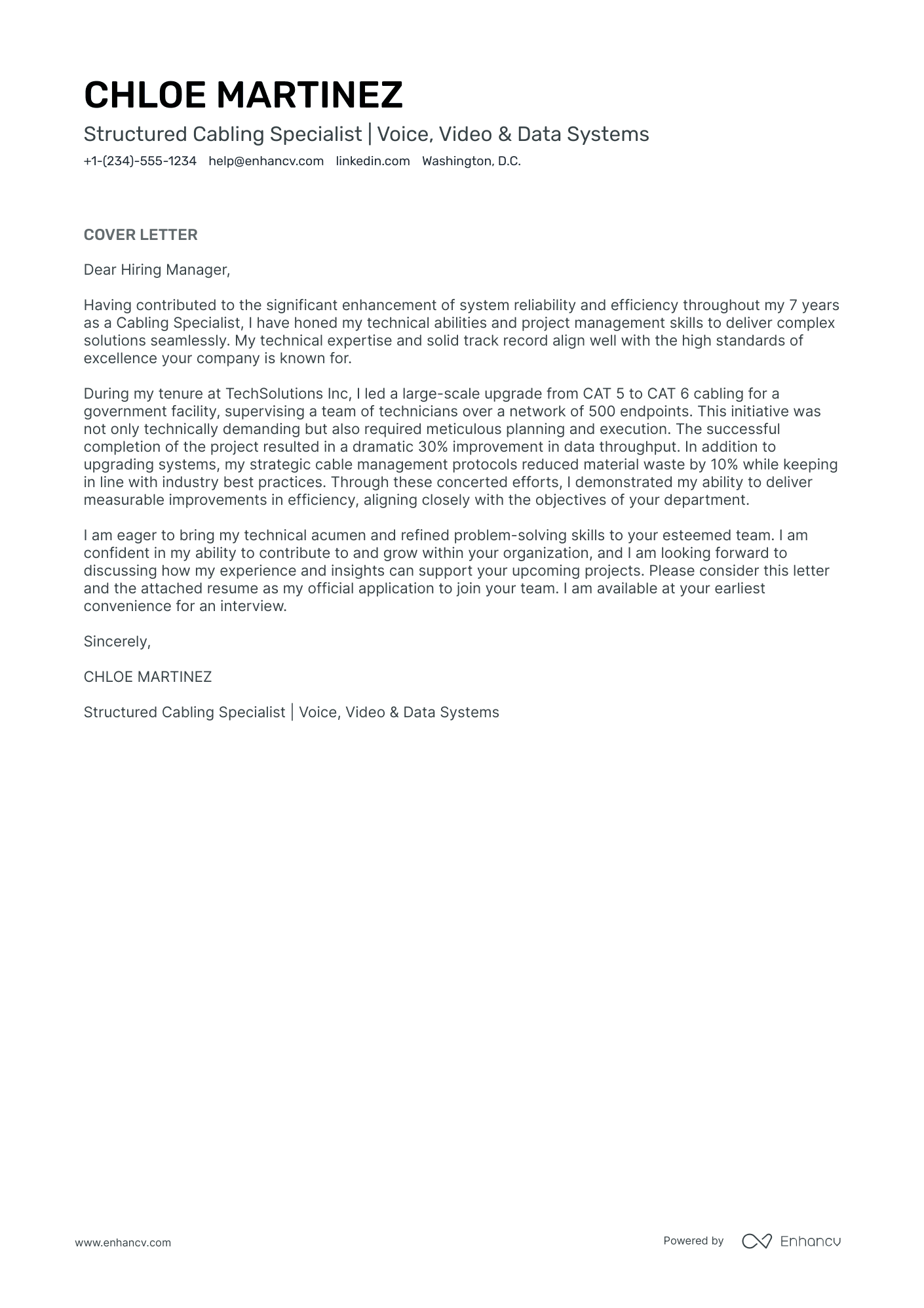Embarking on your job hunt, you've quickly discovered that a compelling construction worker cover letter is just as crucial as your resume. While your resume lists your skills, your cover letter should weave a captivating narrative around your proudest professional milestone without turning into a cliche. Balancing formality with a personal touch, and delivering it all in under a page, might seem daunting. Fear not—this guide is designed to turn that challenge into a blueprint for success.
- Create a construction worker cover letter to persuade the recruiters you're the best candidate for the role;
- Use industry-leading construction worker cover letter templates and examples to save time;
- Dedicate your construction worker cover letter space to your best achievement;
- Make sure your construction worker cover letter meets recruiters' expectations and standards.
Avoid starting at the blank page for hours by using Enhancv's AI - just upload your resume and your construction worker cover letter will be ready for you to (tweak and) submit for your dream job.
If the construction worker isn't exactly the one you're looking for we have a plethora of cover letter examples for jobs like this one:
- Construction Worker resume guide and example
- Electrical Project Manager cover letter example
- Engineering Program Manager cover letter example
- Architectural Project Manager cover letter example
- Automotive Engineering cover letter example
- Electrical Manager cover letter example
- Entry level Civil Engineer cover letter example
- Biomedical Engineer cover letter example
- Senior Electrical Engineer cover letter example
- Manufacturing Engineer cover letter example
- Petroleum Engineer cover letter example
Drop your resume here or choose a file.
PDF & DOCX only. Max 2MB file size.
Construction worker cover letter example
ZOEY WALKER
New York City, New York
+1-(234)-555-1234
help@enhancv.com
- Quantifying Achievements: The cover letter highlights previous work accomplishments with concrete figures, such as "managing concrete placement and finishing on over ten large-scale commercial projects" and leading a team that improved "form production by 25% over six months." This provides tangible evidence of the candidate's skills and impact.
- Demonstration of Relevant Experience: The mention of operating troweling machines for a large 50,000 sq.ft. area shows direct experience with the type of work the role requires, emphasizing the candidate's hands-on expertise in concrete finishing.
- Alignment with Company Values: The cover letter makes a connection between the applicant's values and the company's, specifically noting "continual process improvement"—a value that the candidate understands to be shared by the company, thus reinforcing cultural fit.
- Commitment to Safety: Safety is paramount in construction roles, so the cover letter's mention of a "proven safety track record" assures the hiring manager of the candidate's commitment to responsible work practices.
What are the basics of the design or format of your construction worker cover letter?
To start, here's a reminder for you: the Applicant Tracker System (or software that is used to assess candidate profiles), won't be reading your construction worker cover letter.
Recruiters enjoy reading construction worker cover letters with a standardized format that uses:
- the same font as the resume (e.g. modern ones like Raleway or Volkhov are prefered over the clichéd Times New Roman or Arial);
- single spacing to keep the content concise and organized (this is all ready for you in our cover letter templates);
- a one-inch margin to wrap around the text, like in our cover letter builder;
- PDF as a file format, as it allows your design (and visual element) to stay the same.
Finally, we can't go on without mentioning the key sections of your construction worker cover letter.
In the top one-third, make sure to include a header (with your contact information, name, role, and date), a salutation, and an introduction.
Next, follows the heart and soul of your construction worker cover letter or its body.
End your construction worker cover letter with a closing paragraph and, if you wish, a signature.
Writing a cover letter can take time. Skip the hassle with our free cover letter generator and make one in seconds.
The top sections on a construction worker cover letter
- Header: Include your contact information and the date, which is essential for the recruiter to know who you are and how to reach you.
- Greeting: Address the hiring manager or construction project manager by name to establish a personal connection and show attention to detail.
- Introduction: Briefly state your construction experience and the specific job you are applying for, showcasing your relevance to the position immediately.
- Body: Highlight specific construction projects you've worked on, your hands-on skills, safety record, and collaboration with teams, as these are all critical in the construction industry.
- Closing: Express your enthusiasm for contributing to the company's projects, restate your qualifications, and include a call to action, such as the desire for an interview or site meeting.
Key qualities recruiters search for in a candidate’s cover letter
- Physical stamina and strength – necessary to handle heavy materials and equipment, and to perform physically demanding tasks for extended periods.
- Experience with construction tools and machinery – indicates the ability to safely and proficiently use essential equipment specific to construction work.
- Knowledge of building codes and safety regulations – ensures compliance with legal standards and maintains a safe worksite.
- Teamwork and communication skills – vital for coordinating with other construction workers, contractors, and supervisors to ensure efficient and timely project completion.
- Reliability and punctuality – critical in a role where timelines are tight and delays can have significant financial implications.
- Problem-solving skills – important for quickly addressing challenges that arise during construction projects, such as unexpected site issues or changes to plans.
How to start your construction worker cover letter: with a greeting, of course
Have you ever considered just how powerful a personalized salutation can be?
We sure have news for you! Your construction worker cover letter should start with the right salutation to recruiters, nurturing a sense of respect and individuality.
Greet recruiters by using their first name (e.g. "Dear Tom" or "Dear Patricia") if you've previously established contact with them.
Otherwise, opt out for the less familiar, "Dear Ms. Peaches" or "Dear Ms Kelsey", if you've found the recruiter's name on LinkedIn or a corporate website.
"To whom it may concern" is never a good option, as it creates a sense that you've been sending out your construction worker cover letter to anyone. Instead, use "Dear HR team" or "Dear (company name) recruiter" for a feeling of exclusivity.
List of salutations you can use
- Dear Hiring Manager,
- Dear [Company Name] Team,
- Dear [Project Manager's Name],
- Dear [Construction Manager's Name],
- Dear [Human Resources Director],
- Dear [Mr./Ms. Last Name],
How to start your construction worker cover letter introduction
The opening paragraph of your construction worker cover letter can seem like a real enigma.
Where do you start writing?
In your construction worker cover letter introduction, focus on yourself by stating what:
- gets you motivated and excited about the role;
- you like best about the company, from culture to awards.
Write no more than two sentences, which are both authentic and show your enthusiasm for the opportunity.
Storytelling in the middle (or body) of your construction worker cover letter
You've got your whole resume sorted, detailing your achievements and skills. What else can you write in your construction worker cover letter?
For starters, take the time to re-assess the job requirements and re-discover the most crucial skills and requirements (or keywords).
After making a list of these important keywords, look back on your experience to select just one of your past accomplishments.
Choose the achievement that is the most noteworthy, relevant to the role, and matches the required skills.
Use the next between three and six paragraphs to narrate how:
- you've grown your skill set, thanks to your achievement;
- you'd use the know-how you've gained in your new role;
- your accomplishment could help your potential employers grow.
Remember that recruiters don't need a retelling of your whole resume, but want to find out what makes you, you.
Ending your construction worker cover letter to avoid "sincerely yours"
Yes, this sort of closing statement may work best before your signature.
But you want to give recruiters something more with your construction worker cover letter ending.
Some professionals choose to go down the path of promises. In a single sentence, they map out what they'd bring about to the role (whether that's a particular technical skill set or personal traits).
Others, decide to be more concrete by thanking recruiters for their time and prompting for their next interview.
Whatever path you choose, remember to always be polite and respectful of the opportunity you've had. Good manners go a long way.
Construction worker cover letter advice for candidates with no experience
If you're worried about writing your Construction Worker cover letter and have no professional experience, we sure have some advice for you.
Turn recruiters' attention to your transferable or relevant skills gained thanks to your life and work experience.
Instead of writing about past jobs, focus on one achievement (whether from your volunteering experience, education, etc.) and the skills it has helped you build.
Alternatively, you could focus your Construction Worker cover letter on your career objectives and goals. Always remember to make those relevant to the job you're applying for by detailing how you see yourself growing as part of the company.
Recruiters would be way more impressed with candidates who fit the job profile and can bring about plenty of skills and vision to the table.
Key takeaways
Writing your construction worker cover letter doesn't need to turn into an endless quest, but instead:
- Create an individual construction worker cover letter for each role you apply to, based on job criteria (use our builder to transform your resume into a cover letter, which you could edit to match the job);
- Stick with the same font you've used in your resume (e.g. Raleway) and ensure your construction worker cover letter is single-spaced and has a one-inch margin all around;
- Introduce your enthusiasm for the role or the company at the beginning of your construction worker cover letter to make a good first impression;
- Align what matters most to the company by selecting just one achievement from your experience, that has taught you valuable skills and knowledge for the job;
- End your construction worker cover letter like any good story - with a promise for greatness or follow-up for an interview.
Construction Worker cover letter examples
By Role



























